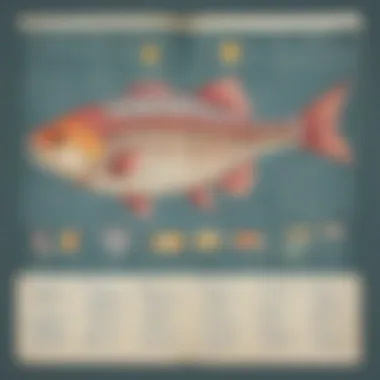Exploring the Fishbone Graphic Organizer: A Comprehensive Guide


Intro
The use of visual aids in education has transformed how students and educators approach complex problems. One such notable tool is the fishbone graphic organizer. It is often used for dissecting intricate issues by breaking them down into manageable components. Whether in a classroom setting or at home, learners across different ages can benefit immensely from this tool. This article will expand on how the fishbone diagram can enhance problem-solving skills while offering a framework for critical thinking.
Interactive Learning Games
Learning does not have to be confined within traditional boundaries. One effective way to engage students is through interactive learning games, complemented by analytical tools like the fishbone graphic organizer. These games capture attention while encouraging thoughtful exploration of new concepts.
Popular Games
Several learning games have gained popularity in educational circles. Appropriate selections can turn any lesson into an engaging experience.
- Kahoot!: This platform allows teachers to create quizzes that students can answer in real-time, promoting quick thinking.
- Minecraft: Education Edition: A sandbox game that encourages creativity and problem-solving.
- Prodigy Math: An immersive math problem-solving game that adapts to a child’s learning level.
Description of Top Educational Games
These games each have unique features designed to optimize learning.
Kahoot! transforms quizzes into competitive round-robin sessions. Educators and learners both appreciate its fun format.
Minecraft: Education Edition emphasizes creativity by enabling students to build and explore virtual worlds, fostering a sense of collaboration.
Prodigy Math makes math problems relatable through storylines that captivate the imaginations of young learners.
Benefits of Playing Educational Games for Kids' Cognitive Development
Engagement in interactive games enhances cognitive development through the following ways:
- Problem-Solving Skills: Games require players to think critically and develop strategies.
- Social Interaction: These games often necessitate collaboration, which can enhance social skills.
- Motivation: Successfully completing game tasks boosts self-esteem and provokes further interest.
Game Reviews
In reviewing educational games, let's delve into specific ones. Each game offers diverse pathways for learning.
Kahoot!: Pros include its ease of use and instant feedback for players, while cons might be limited to internet connectivity issues.
Minecraft: Education Edition: This game stands out for its expansive environment, yet it demands significant time investment.
Prodigy Math: Its engaging narrative draws users, but excessive playtime can detract from other learning objectives.
Comparison of Gameplay and Learning Outcomes
Analyzing the outcomes of each game reveals variations in their effectiveness for learners. Kahoot! emphasizes immediate recall and competition, ideal for review sessions. In contrast, Minecraft promotes long-term strategic thinking, helping students to visualize concepts in spatial dimensions. Prodigy Math provides tailored Challenges to individual learning needs.
Through active participation, learners can utilize tools like the fishbone graphic organizer to analyze and discuss the challenges encountered in these games. This additional step can enable a deeper understanding of strategies applied during gameplay.
Educational Topics
A fundamental aspect of understanding includes diverse educational topics such as math, science, and literature. A well-rounded approach leads to interdisciplinary learning, providing numerous perspectives.
Importance of Interdisciplinary Learning for Holistic Development
Combining subjects allows learners not only to gain multiple skills but also to understand how themes connect across various domains of knowledge. For example:
- Math and Science: Astronomy incorporates calculations for orbital patterns.
- Language and Art: Developing narratives for visual representations fosters creativity.
Tips and Tricks
Making learning more effective often comes down to strategy. Some practical tips include:
- Use readily available resources like trash items for imaginative projects.
- Encourage student-led discussions around game experiences for rich insights.
- Promote a flexible structure for educational sessions, allowing freedom for exploration.
Integrating ideas from activities enhances engagement. Tailoring sessions encourages individual interests while creating a community of quite the learners.
Creative DIY Projects
Incorporating
Prolusion to Fishbone Graphic Organizer


Definition and Purpose
The fishbone graphic organizer, reffered to as the Ishikawa diagram, serves a vital role in dissecting complex problems. It allows users to visualize the cause-and-effect relationship by displaying possible causes of a specific problem on a centralized bone structure. This representation helps in breaking down intricate issues into more manageable parts. The objective is not only to provide clarity but to stimulate logical thinking among students and learners alike. Utilizing this organizer supports systematic analysis, enabling teams to approach problems methodically. Therefore, understanding its definition and purpose becomes fundamental for educators aiming to enhance analytical skills among their students.
Historical Context
The origins of the fishbone diagram date back to the 1940s when Kaoru Ishikawa first introduced it in Japan for use in quality control. Over decades, its applications extended beyond manufacturing, infiltrating various fields including education and management. Understanding its historical roots illuminates the persistence of its relevance in modern contexts. The incorporation of data visualization tools into problem-solving processes has evolved significantly. Yet, the core principles connected to Ishikawa’s initial design persist, ensuring the fishbone graphic organizer remains an essential tool in dissecting multifaceted issues.
Importance in Education
In education, the fishbone graphic organizer stands out as a significant pedagogical tool. It encourages students to delve deeper into problems, fostering an environment of critical inquiry. By structuring thoughts around possible causes, educators can guide discussions and enhance collaborative learning. This approach not only promotes engagement but nurtures essential skills such as analysis and synthesis of information.
Furthermore, the fishbone diagram assists in visually organizing information, making it accessible to students with diverse learning styles. In summary, its incorporation into curricula holds notable potential for improving student outcomes. As tutors and educators integrate this tool, they bolster facilities for analytical thinking, creativity, and systematic problem-solving strategies among young learners.
The fishbone graphic organizer demonstrates outstanding value in visual thinking and exploring the roots of problems. It encourages children to observe and analyze comprehensively.
Components of the Fishbone Diagram
Exploring the components of the fishbone diagram reveals insights into its structure and functionality. Understanding these elements is vital for effective application, particularly in educational contexts. The diagram aids in dissecting problems more deeply by visualizing various factors at play. It allows for a systematic approach to problem-solving, essential for teachers, students, and educators alike.
The Main Bone and Head
The main bone of a fishbone diagram represents the core problem or issue that needs to be addressed. Everything centers around this part of the diagram, allowing focus on the matter at hand. The area at the head symbolizes the ultimate idfentity of the problem or goal. This clarity offers a direct way to approach solutions and analysis.
When defining the problem in this section, it’s crucial to be both specific and clear to guide the ensuing analysis effectively. If the main issue is vague, the reasons identified later may also lack relevance or insight. For educators, outlining concise problems enhances inclusivity in group discussions, ensuring all participants, including children, fully grasp the issue.
Categories of Causes
This section involves categorizing various causes around the main bone. These categories often include aspects like people, materials, methods, machines, measurements, and environment. By grouping related reasons, the organizer breaks down a complex problem into manageable sections.
In an educational setting, categories should account for students’ perspectives and understanding abilities. Ensuring diverse viewpoints and experiences will yield richer discussions and solutions. Categories also help students identify specific areas of intervention, from recognizing an environmental obstacle to addressing improper methods in their tasks.
Detailed Causes
By diving into the more refined aspects of each category, the section revolves around identifying specific incidences of potential causes. This could involve discussing individual behaviors leading to an issue or imbalances in materials affecting learning outcomes.
Detailing the causes creates a direct link between observable and underlying factors in the problem, enriching educators' understanding. Differentiating between key causes provides clarity, allowing for the formulation of targeted solutions. As students engage in this process, they enhance their ability to critically evaluate situations and iterate upon their findings.
Exploring the intricacies of the Fishbone diagram supports not only teachers but all parties involved in education, fostering a more robust learning atmosphere.
Creating a Fishbone Graphic Organizer
Creating a fishbone graphic organizer involves critical thought and planning. This tool greatly helps in problem-solving. Distinct causes and effects of an issue become clearer through visualization. By engaging with the fishbone diagram, educators encourage systematic thinking among students. This method is particularly useful for breaking down complex subjects into manageable parts. Clear organization leads to better understanding, driving learners to explore deeper insights into any given problem.
Step-by-Step Guide
A step-by-step process for constructing a fishbone graphic organizer can be effective for educators and students alike. Here’s how to create one:
- Identify the main problem or goal to focus on. Ensure that everyone understands the central issue.
- Draw a long horizontal line to symbolize the main “bone.” Place the problem statement at the head of the fishbone diagram.
- Determine primary categories related to the main issue. These will form the major “bones” off the central line. Consider categories such as people, methods, materials, and environment.
- Under each category, brainstorm and list detailed causes contributing to the central problem. These are like the smaller bones branching off.
- Review and discuss each cause. Ask questions and refine as needed for clarity.
- Continue modifying until the diagram is comprehensive and accurately reflects the problem's dynamics.
Follow these steps to make a detailed organizer for effective analysis of any issue.
Tools for Creation
Using the right tools can substantially enhance the process of creating a fishbone diagram. Education professionals often rely on various resources:
- Graph paper/pencils: Classic and effective for drawing by hand.
- Whiteboard and markers: Great for live brainstorming sessions.
- Software options such as Lucidchart and Creately can offer digital convenience. They allow for instantly adjustable diagrams and ease of collaboration.
- Templates available online can provide structured formats. These help in simplifying the creation process and skipping a few design steps.
Incorporating technology can boost creativity while allowing numerous options to visualize difficult concepts.
Examples of Completed Diagrams
Examples can provide clarity on how a fishbone diagram should be laid out. A completed fishbone can arise from various contexts:
- In a school project, students may explore “Factors Causing Pollution” with categories like “Transportation,” “Factory Emissions,” and “Waste Management.”
- For a parenting workshop, diagrams could analyze “Challenges with Homework” indicating “Difficulty of Tasks,” “Distractions,” and “Time Management.”
- In teamwork setting, addressing a product assessment might entail categories like “Customer Feedback,” “Market Trends,” and “Communication Gaps.”
Such diverse applications highlight the versatility of the fishbone organizer in addressing specific challenges. Reviewing these complete diagrams can inspire learners and educators in their efforts, solidifying the diagram as a necessary educational tool.
Applications in Educational Settings


The fishbone graphic organizer, with its focused structure for examining problems, proves essential in educational environments. By visualizing complex issues, it enables students and educators to engage deeply with material while promoting critical thinking skills. Various applications can be derived due to its intuitive layout, enhancing adapted eduacational approaches, in the claassroom and beyond.
Problem Solving in Classrooms
In classrooms, the fishbone graphic organizer aids in identifying the root cause of problems effectively. Teachers can use this tool when discussing various subjects. For instance, in a science class tackling environmental issues, students might be guided to pinpoint contributory factors like pollution, waste management, or governmental regulations. This focused approach nurtures analytical thought processes.
Benefits of using the fishbone diagram in problem-solving include:
- Clarity: Students visually connect various cause-and-effect relationships.
- Engagement: It encourages participation among students as they work collaboratively on diagrams.
- Ownership: Learners take responsibility for identifying solutions through investigative inquiry.
Cross-Disciplinary Uses
The versatility of the fishbone diagram reinforces its use across subject areas. Teachers can integrate it into history, mathematics, literature and arts education, pushing students to think across boundaries. When utilizing the fishbone diagram in a cross-disciplinary activity, students may learn history by unraveling the reasons behind significant events or computing probability through complex scenarios in math.
The following examples showcase cross-disciplinary benefits:
- Linking literature themes to historical events, analyzing character motivations through prompts.
- Exploring mathematical patterns in nature and discussing implications through scientific inquiry.
Collaborative Learning
Collaborative learning flourishes through the appliication of fishbone diagrams. In group settings, students can work collectively to build their diagrams, combining knowledge and sharpening communication skills. This interaction facilitates shared perspectives and leads to enriched discussions among peers about the nature of problems.
Topoics for collaborative learning through fishbone can include:
- Group Projects: Fostering responsibility and leadership qualities as they explore the organizer during discussions.
- Peer Reviews: Evaluating each other's work encourages critique and improvements.
- Problem-Solving Initiatives: Students share independent findings, promoting diverse viewpoints.
Enhancing Critical Thinking Skills
Enhancing critical thinking skills is vital for learners, particularly in today's educational landscape. The fishbone graphic organizer occupies a central role in nurturing these skills, as it provides a structured approach to problem-solving. By using this tool, students not only learn to identify causes behind problems but also develop the habit of asking meaningful questions.
Encouraging Inquiry-Based Learning
Inquiry-based learning stimulates students to seek answers actively rather than passively receiving information. Utilizing the fishbone diagram allows learners to break down problems visually, encouraging them to ask why certain factors influence outcomes. It helps them develop a mindset geared towards exploration and curiosity.
By presenting issues in a structured manner, educators can create a conducive environment for inquiry. For example, a lesson on environmental issues can be transformed using the fishbone diagram. Students can list main effects and then dissect those effects to explore their root causes. This method not only makes learning engaging but also sensitive to real-world complexities.
Fostering Analytical Thinking
Analytical thinking is required for critiquing information and drawing conclusions from data. The fishbone graphic organizer effectively mirrors this skill as students identify different categories of causes associated with a problem. It invites them to analyze each element critically, ensuring they view the situation from multiple perspectives.
For instance, if students choose to analyze a decline in classroom engagement, they might position factors like curriculum relevance, teaching styles, or student interests on the diagram. They can then delve deeper into these categories to analyze effects on learning. Such practice cultivates an analytical lens necessary for sophisticated decision-making.
Promoting Creativity in Solutions
Creativity is paramount for finding effective solutions to problems. The use of fishbone diagrams paves the way for innovative thinking by visualizing an issue and recognizing potential avenues for resolution. This grounding in structure can paradoxically liberate students to think freely.
Through this organizer, students can gather diverse perspectives in detailing causes for an issue, mixing logical structure with creative liberty. A group project might involve students coming together to brainstorm solutions based on their diagram findings. Here, each contributor's creative input shapes collective strategies. Thus, the fishbone diagram stands as a bridge between analytical thinking and a creative approach to problem-solving.
"Encouraging students to employ the fishbone graphic organizer can transform educational dynamics, enhancing their critical thinking abilities during collaboration and analysis."
Adapting Fishbone Organizer for Young Learners
Adapting the fishbone organizer for young learners is crucial for several reasons. First, children benefit from clarity and simplicity. When they encounter a structured tool, they can better analyze problems. This itself nurtures essential critical thinking skills. Moreover, the engaging nature of the fishbone diagram captures children’s attention more effectively than traditional methods.
It's important to acknowledge the unique needs of younger students. Educators and caregivers must tailor this tool accordingly, prioritizing ease of use without diluting its analytical strengths. Here, we explore specific strategies to optimize the fishbone organizer for younger audiences.
Simplifying Concepts
When using the fishbone organizer with young learners, simplifying concepts makes a profound impact. Children struggle with abstract ideas, so using clear language is vital. Educators should start by presenting a single problem at a time. Instead of overwhelming students with multiple causes, focus first on the main issue at the head of the fishbone.
By using short phrases and familiar terms, kids enhance their understanding. Visual elements can also play an important role. Use drawings or icons that resonate with younger demographics to represent different cause categories.
Structured instructions, step-by-step, guide children in constructing their fishbone diagrams successfully.
Incorporating Playful Elements
Incorporating playful elements is another effective strategy. Learning is inherently more engaging when it includes games or favorite stories. One practical method is to transform the fishbone organizer into an interactive activity. Use colorful markers, stickers or themes that children enjoy—like animals or space themes.
Making the session interactive increases motivation. Grouping students to work collaboratively can also foster a sense of community. This typically lasts longer than if they felt they were working independently. Educators might consider reward systems for completion, like badges. These options will amplify enthusiasm and create a fun learning environment.


Real-Life Scenarios
Connecting lessons to real-life scenarios is a powerful way to reinforce concepts. Younger learners engage more deeply when they relate academic content to everyday experiences. Educators should present relevant, age-appropriate problems, such as planning a simple school event or choosing a snack for a group.
When faced with these familiar situations, students can easily identify causes that affect their main issue. Planning the school event? Have them brainstorm possible challenges, like venue constraints or snacks selection.
By guiding them through the process using the fishbone organizer, educators can solidify their reasoning and critical thinking skills effectively. As a result, this concrete approach closes the gap between theoretical knowledge and practical application.
By adapting the fishbone organizer for young learners, educators unlock a potent tool tailored to cultivate analytical thinking skills while remaining accessible and enjoyable.
Challenges Facing Educators
Educators are pivotal in guiding students through learning experiences, particularly when utilizing tools like the fishbone graphic organizer. However, they encounter distinct challenges that can hinder the effective implementation of such strategies. Understanding these challenges is crucial for maximizing the fishbone diagram's impact on critical thinking and problem-solving skills in learners.
Resistance to New Tools
One substantial barrier that teachers face is resistance to new tools among both students and fellow educators. The effectiveness of teaching strategies may rely on acceptance and willingness to adapt to innovative methods. Some teachers may feel comfortable with familiar methods and perceive the fishbone diagram as an unnecessary complication. Others may worry that learning a new tool will require additional training time and resources, thereby disrupting established curricula.
For students, particularly in younger age groups, the change can be daunting. They might feel lost or frustrated when introduced to a new format, possibly leading to a lack of engagement. To ease this transition, educators can focus on gradual integration. Initial exposure can occur through minor adjustments in lessons that do not disrupt the overall flow of learning.
Encouraging feedback and open discussions about the fishbone organizer can also help alleviate concerns. From demonstrations to workshops, building confidence in both faculty and students is essential. This approach toward new tools helps in breaking down fear barriers and fosters an environment receptive to diverse educational methods.
Skill Level Variability
Another challenge is the variability in skill levels among students, which can influence how well they utilize the fishbone graphic organizer. In a classroom, students come with varied backgrounds and experiences, which directly affects their ability to grasp concepts tied to problem-solving frameworks. Some may find it easy to dissect problems and craft solutions, while others may struggle with even the basic concepts of categorizing ideas on the diagram.
Educators need to implement tiered support structures to cater to different learning abilities. For example, providing scaffolding in earlier grades can help students familiarize themselves with simpler concepts before entering into more complex analyses. The organizer can be adjusted according to learners' needs, which may include simplifying categories or allowing for collaborative group efforts.
By fostering an inclusive classroom environment where all students can contribute at their respective levels, teachers can enhance the learning experience. Using collaborative approaches helps bolster peer understanding and can ease the learning process. Ultimately, addressing these disparities promotes more equitable learning opportunities among students.
Navigating the challenges of implementing a fishbone graphic organizer effectively requires commitment from both teachers and students, focusing on gradual integration and strong support systems.
Resources for Further Exploration
The fishbone graphic organizer has vast applications in educational settings. To maximize its effectiveness, both educators and students can benefit greatly from various resources that deepen their understanding and skill in utilizing this tool. By exploring credible literature, varying techniques, and practical applications offered through technology, a broader perspective emerges. These resources not only enhance comprehension but also inspire creativity in problem-solving strategies.
Books and Articles
Reading dedicated books and articles enriches knowledge of the fishbone method, offering both theoretical background and real-world applications. Several recommendation include:
- **
Ending
The conclusion serves as a critical component of this article, encapsulating the essence of using the fishbone graphic organizer in education. As we have explored, the fishbone diagram provides a structured method for ~visualizing complex problems. Its clarity affords teachers, parents, and caregivers a reliable tool to foster problem-solving skills in children.
By summarizing the key points discussed in previous sections, we recognize the fishbone guider as more than just a diagram. It promotes a deep understanding of causes and effects. This aids learners in grasping the nuanced layers of challenges they may face.
As we implement such methodologies in educational settings, we address the importance of adaptability. Every learner is unique, bringing their own perspectives and abilities. Addressing this variability strengthens the application of the fishbone organizer.
The numerous benefits that come from utilizing the fishbone graphic organizer include
- Systematic exploration of issues,
- Encouragement of analytical reasoning,
- Facilitation of collaborative learning environments.
By equipping learners with critical analytical tools, we prepare them for more complex tasks ahead. Thus, educators must prioritize integration of techniques like this in curricula to complement standard pedagogical methods.
"Educational tools like the fishbone graphic organizer not only enhance comprehension but transform learners into effective problem solvers."
Through constructive engagement with the fishbone diagram, educators enable students to develop life skills. These include analytical, creative, and collaborative abilities that transcend typical academic confines. Ultimately, fostering an active learning mindset can deeply affect future educational engagements.
Recap of Key Points
In summary of the points discussed throughout this article:
- A fishbone graphic organizer effectively structures complex problems,
- Its application across different disciplines enhances educational outcomes,
- Combining critical thinking development and problem-solving skills is crucial.
We understand the crucial role these diagrams play in helping children decompose multifaceted issues into manageable elements. When loci are simplified, learning can become a constructive and engaging experience.
Future Directions in Education Technology
Looking ahead, the futures of education and technology hint at substantial innovations. The probability for digitally enhanced fishbone graphic organizers in interactive platforms might become available. With the right advancements, educators can offer adaptive learning environments through software tailored for student needs.
Available educational technologies may soon deepend the interaction with the digitized fishbone organizer. This could allow for:
- Real-time collaboration,
- Cloud-based discussions,
- Analytics on student engagement and comprehension.
By leveraging trends in technology, we can build future learning agendas benefiting from methods like the fishbone diagram. Keeping pace with these possibilities is essential for educators who thrive on enhancing student intellect. Ultimately, strategies grounded in technology can optimize these traditional methods, offering unprecedented access to educational depth and detail.















